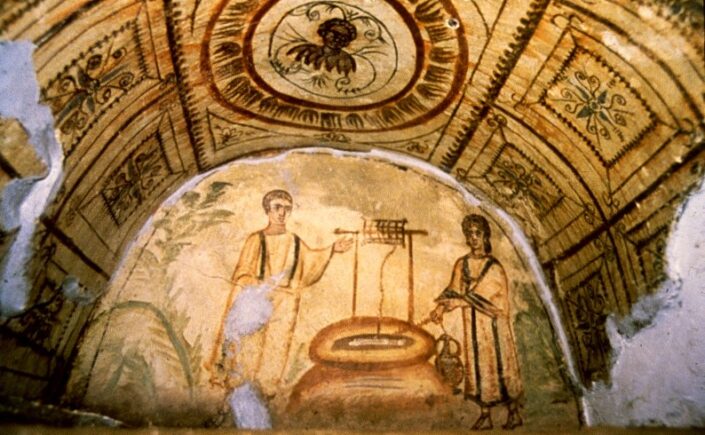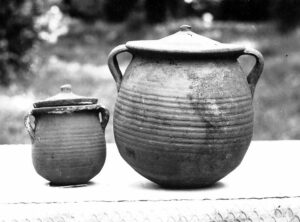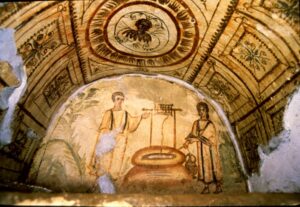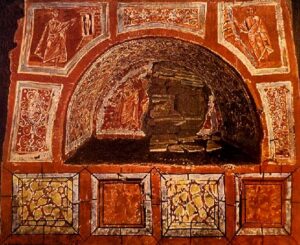Water: Salvation. Excerpt from: Estelle Shohet Brettman, Vaults of Memory: The Roman Jewish Catacombs and their Context in the Ancient Mediterranean World, rev. ed. Amy K. Hirschfeld, Florence Wolsky, & Jessica Dello Russo. Boston: International Catacomb Society, 1991-2017 (rev. 2024).
According to ancient Egyptian thought, the moisture of the body must be restored after its withdrawal in the mummification process. In his absorption into Osiris, the great god associated with the Nile, the deceased receives the moisture from Osiris' body ("may Osiris give you cool water,")[1] and is reborn into divine life by this fusion.[2] Rameses IV, identifying Osiris as the Nile, states that "gods and men live by the moisture that is in thee."[3] The merging with divinity is evocative of Pauline theology: "For as the body is one, and hath many members... so also is Christ. For by one Spirit are we all baptized into one body... and have all been made to drink into one Spirit (I Cor. 12:12-13). In the gnostic Gospel of Thomas Jesus says to Thomas: "He who will drink from my mouth will become as I am. As for me, I will become he."[4] Expressed in John is the idea of the faithful becoming one not only with Jesus (John 6:56; 15:4,7) but also with God, because Jesus is in God (John 14:19-20).
From ancient times receptacles for liquid, most likely water, such as the aptly named “pilgrim flasks” of the Mycenaean period,[5] were placed in burials so that their contents could replenish precious body fluids, and provide liquid refreshment, an important element in the approximately seventeen-hundred year later refrigerium of the catacombs.
As mentioned above, burial in the Greek water pot, the hydria, often a repository for ashes from the Archaic period (early sixth century B.C.E.), could have been related to the concern about the scarcity of water in the afterlife either for imbibing or for purification.[6] Vessels and equipment for providing water for the departed as well as for those celebrating their memory are present in the catacombs and figure in the imagery of these underground archives.
Fig. 1. Two clay pots with covers. From the Villa Torlonia. Catacombs, Rome.
The need for water upon awakening from the "sleep of death" was recorded by the Egyptians as early as the Pyramid Text, wherein a son, as officiant, urges his departed father to "... arise! Take to thyself this water..."[7] The deceased pharaoh, Pepi, was also bid by the funerary priest bringing food and water: "Raise thee up, King Pepi, receive to thee thy water [of rejuvenation]. Gather to thee thy bones...”[8] This is also a ritual for Osiris during the observance of his funerary rites. Anxiety over the absence of water is expressed both in the New Kingdom plaint of the deceased-"He who liked to drink is in the land which hath no water"[9]- and in the Egyptian instructions to "put water for thy father and mother who rest in the valley."[10]
Fig. 2. In a setting with three palm trees, the deceased Ani and his wife cup their hands to drink the waters of the other world. The taller center tree bears pendent date clusters beneath the three palm fronds growing from each side, making seven with the central trunk. This calls to mind the sacred seven-branched candelabrum. The palm tree could also indicate the presence of the tree-goddess and be a site for the departed to partake of divine beneficence.[11] Indeed, the next vignette in this papyrus pictures the tree goddess performing her benevolent role.
The quenching of the thirst of the weary traveler to the Field of Rushes (analogous to the Greek Elysian Fields) is alluded to frequently in ancient Egyptian funerary texts and paintings. Similarly, the ever-thirsty Greek dead had recourse to the legendary watering holes of Mnemosyne (Memory) and Lethe (oblivion). An early instance of the dead encountering water occurs in the Pyramid Texts where the deceased King Pepi approaches the shore of the Lily-lake "the drinking-place of every glorious one" ("Glorious," like "blessed," being an Egyptian euphemism for deceased).[12]
Echoing similar beliefs, a sumptuous Greek funerary gold-leaf Baedeker from fourth century B.C.E. Pharsalos, Thessaly, guided the deceased followers of Orphism to the precise location of the well-guarded "cold water spring running from the Lake of Memory" in Hades.[13] The deceased must entreat the custodians to allow him to drink the water that flows from the Lake of Memory so that he will receive the water from the sacred fountain, thus enabling him to "live and rule with those that live a life of blissful consciousness."[14] The Orphic gold-leaf instruction is suggestive of the Roman gold glass of the catacombs, not only because it is fashioned with precious gold leaf but also because this glass often conveys a message with a similar connotation.
Fig. 3. Within the broken rim of a fragment of gold glass, the Greek legend, transliterated into Latin, exhorts: "ANASTASI PIE ZIES" or "Anastasios, drink, live." This same counsel is also inscribed on gold glass from the Christian catacombs. "Anastasios" stems from the word for "rising up" or "resurrection." In the upper register, a baldachin-like shrine, opened to reveal six Torah scrolls, is guarded by two alert lions (presumably "lions of Judah ").[15] In the lower register, two flaming menorahs tower over shofars and an amphora. These cult objects flank the lulav (a palm branch, here bound together with aravah shoots) and the ethrog (a citron), vegetation used to celebrate the Feast of Tabernacles.[16] Apparently the bottom of a drinking vessel.[17]
The saving water imagery of the Orphic guide finds parallels in the New Testament. "And he shewed me a pure river of water of life," records the author of Revelations (22:1; 21:1-2), "clear as crystal proceeding from the throne of God." Precedents for this passage may have been the life-giving rivers flowing forth from under the threshold of the Temple in the prophesy of Israel reborn (Ezek. 47:1, 5, 9).[18] In Psalm 23 (1, 3), the Lord assumes the guise of a shepherd, leading his followers "beside the still waters,'' restoring their souls, and establishing them on "the paths of righteousness" or "right paths. "[19]
This luxurious early atlas in Orphic prose had its antecedent in the Egyptian Book of the Two Ways. recorded on Middle Kingdom coffins. The book's map aided the voyager in his journey to the next world by apprising him of lurking evils and assist him in choosing the right path to the ultimate goal, the Field of Yaru or Field of Rushes. According to the Book of the Dead (influenced by the Book of the Two Ways included in its predecessor the Coffin Texts), the Egyptian following its instructions was offered the imperishability of a celestial body: "He drinks the running water of the stream, he shines like a star in the sky."[20] Imbibing water from a stream (the source of which is "the mighty flood by Osiris") enabled the deceased to "inherit eternity" and "everlastingness.”[21]
In contrast, in the absence of water, the lost wandering wife of an Egyptian priest in the Ptolemaic period complained that "The water of life which contains the sustenance of every life is for me thirst. It falls [only] to him who is upon earth. I am thirsty although water is beside me, I do not know the place where I am.... "[22]
Fig. 4. Even though of a later period, this lament could describe the plight of Lady Cheritwebeshet, confronted in the afterlife by a sinister crocodile.[23] Here she is seen in an eyeball-to eyeball encounter with the creature while attempting to drink waters in front of a stylized tree growing near the stream. A feathery tree, perhaps the reputedly nurturing sycamore, appears to reach out behind the threatening beast. The tableau is completed by a lion (only the leonine head is visible in this photo), who presumably is fulfilling his role as a guardian.
Water was construed by the Israelites as a gift from God; its absence as a punishment. To the rebellious children of Israel, a forgiving Lord declares that they shall hear "a word... saying, this is the way, walk ye in it, when ye tum to the right hand, and when ye turn to the left... and there shall be... rivers and streams of water" (Is. 30:21, 25).
Like a plant in need of water, the faithful follower of the Lord would thrive like "a tree planted by waters." In the same vein, the Lord promises the faithful devotee who keeps his commandments he "will give rain in due season, and the land shall yield her increase, and the trees of the field shall yield their fruit" (Lev. 26:3-4).131 In contrast, the Lord promises the impious that he "shall inhabit the parched places in the wilderness" (Jer. 17:5-8).
Perhaps the carving on the early Near Eastern cylinder seal depicting the sharing of a communal drink represents the imparting of divine wisdom to a devotee. This thought evokes the attributes of Ea, the Mesopotamian god of wisdom as well as the god of the "watery deep," (which gives rise to all earthly sweet water). The thirst for wisdom is compared to the thirst of those who drink water and still thirst for more (Sirach 24:21). The power of God-given waters for eternal life is described in the New Testament: "I will give unto him that is athirst of the fountain of the water of life freely" (Rev. 21:6). Like the spring spurting forth from the rock, the "well of the wilderness" represents spiritually the Torah, Wisdom, the Logos (or God's Word). "Understanding is a wellspring of life unto him that hath it" (Prov. 16:22). Wisdom personified as mother and wife "will give him [that taketh hold of the Torah and feareth the Lord] the waters of knowledge to drink" as well as "the bread of understanding" (Sirach 15:1-3). The Word which Jesus has spoken to them is God and Jesus (John 1:1, 14), and "cleans" the faithful (John 15:3)--signifying baptism, and recalling the Babylonian purifying "lord of the holy incantation who restores to life the dead".
The power of God-given waters for eternal life is described in the New Testament as follows: "I will give unto him that is athirst of the fountain of the water of life freely" (Rev.21:6). Like the spring spurting forth from the rock, the "well of the wilderness" spiritually represents the Torah, Wisdom, and the Logos (or God's Word). "Understanding is a wellspring of life unto him that hath it" (Prov.16:22). Wisdom personified as mother and wife "will give him [that taketh hold of the Torah and feareth the Lord] the waters of knowledge to drink" (Sirach 15:1-3).
The word which Jesus spoke "made clean" the faithful (John 15:3, RSV). Signifying baptism, it recalls the Babylonian purifying "lord of the holy incantation who restores to life the dead.”[24] As described in the thirtieth Ode of Solomon, the mystical well is a "living fountain," Logos or "Wisdom of God" "flowing from the mouth of God" which is imbibed at the hand of "blessed ministers" to gain well-being and immortality.[25]
In the hymn to wisdom in the apocryphal Baruch (Ill, 12), water is equated with wisdom and the Torah, “Thou hast forsaken the fountain of Wisdom."[26] And in the apocalyptic II Esdras (14:39~0) when Ezra drank of "the full cup, which was full as it were with water, Wisdom grew up in his heart and his spirit retained his memory."
In passages from the psalms the physical craving for water translates into a metaphor for the yearning after God, who quenches spiritual as well as bodily thirst: "O God thou art my God; early will I seek thee: my soul thirsteth for thee, my flesh longeth for thee in a dry and thirsty land, where no water is" (Ps. 63:1). Or as expressed in a poetic simile, "As the hart panteth after the water brooks, so panteth my soul after thee, 0 God. My soul thirsteth for God, for the living God" (Ps. 42:1- 2). These verses recall a New Kingdom prayer, in which the devout Egyptian addresses his god, a source of "spiritual refreshment" (evocative of the refrigerium and the cooling waters offered by the saving god Osiris), as: "Thou sweet well for him that thirsteth in the desert."[27] The power of God-given waters for eternal life is described in the New Testament: "I will give unto him that is athirst of the fountain of the water of life freely" (Rev. 21:6).
Fig. 5. Amidst the trees of the countryside, Jesus, in tunic and pallium. discourses with the Samaritan woman. Arrayed in earrings and a belted tunic, she either has drawn water from Jacob's well with her amphora or is about to do so (John 4:4-30). The vault is embellished with stylized floral designs terminating in volutes and enclosed within rectangles. Painted rear wall of the left arcosolium in Cubiculum F, Catacomb of via Dino Compagni, Rome.
Jesus recounts the salubrious effects of the water that he offers: "But whosoever drinketh of the water that I shall give him shall never thirst; but the water that I shall give him shall be in him a well of water springing up into everlasting life" (John 4: 14). Similarly, in the sixth Ode of Solomon, the author describes a "river great and broad" which "brought everything to the temple" as a "drink... from the Most High... The ministers of that drink... have refreshed the parched lips... even living persons who were about to expire, they have held back from death. And limbs which had collapsed they have restored and set up. They gave strength for their coming, And light for their eyes. Because everyone recognized [them] as the Lord's, and lived by the water of eternity."[28] This gift is reminiscent of the exhortation from Isaiah (55: 1, 3): "Ho, every one that thirsteth, come ye to the waters, ... Incline your ear, and come unto me: hear and your soul shall live; and I will make an everlasting covenant with you." A similar invitation is given by the Spirit and the Bride (the Church) in Revelations 22:17.
Fig. 6. Biblical and New Testament concepts of salvation are vividly juxtaposed in the imagery of the catacomb of Domitilla. On the right side of the facade of the "arcosolium rosso" is the image of Moses striking the rock. On the left, Jesus raises the bound, mummiform Lazarus, who stands in the open doorway of his aedicula-like tomb. Between and below these scenes are the embellishments of the usual framed vegetal scrolls and faux marbleized decorations. On the rear wall of the arcosolium are vestiges of a painting depicting Peter under an arch decorated with scale-like patterning. These powerful synthesized images were anticipated as early as Old Kingdom Egypt, when the deceased pharaoh was enjoined: "Thy water for thee... issued from Osiris. Gather together to thee thy bones, stretch out for thee thy limbs... loose for thee thy bandages. Opened for thee is the tomb, undone for thee are the doors of the coffin."[29]
Thus water, whether present in the catacombs either symbolically or in reality, bore a significance richly charged with multi-level meanings and associations for the Roman world, just as it did for the cultures which preceded it.
[1] Inscriptiones Graecae XIV, 1488
[2] Samuel A. B. Mercer, The Pyramid Texts in Translation and Commentary (New York, 1952), I, p. 149.
[3] James Henry Breasted, Development of Religion and Thought in Ancient Egypt (New York, 1912), p. 18, and n. 13.
[4] J. M. Robinson, The Nag Hammadi Library (New York, 1977), p.129, 1.108, also I Cor. 10:4
[5] Their use dates from the late fifteenth century B.C.E.: E. T. Vermeule, Aspects of Death in Early Greek Art and Poetry (Berkeley: University of California Press, 1979) p. 58.
[6] These utilitarian vessels also served for libations in a ritual believed to assuage the thirst of the dead, and see Kurtz and Boardman, Greek Burial Customs (London, 1971), pp. 209-210 for broader discussion of drinking vessels in Greek burials placed conveniently for use in the afterlife.
[7] Mercer, I, p. 280, Utterance 662, §§ 1877e-1878c.
[8] E. A. W. Budge, The Book of the Dead (London, 1969 ed.), n, p. 312.
[9] Translated by E. Lüddeckens, "Untersuchungen über religiösen Gehalt, Sprache und form der ägyptischen Totenklagen" in Mitteilungen des Deutschen Archaologischen Instituts, Abteilung Kairo. 11 (Berlin, 1943), p. 134.
[10] Breasted, Religion and Thought, p. 362.
[11] From The Book of the Dead: Facsimile of the Papyrus of Ani (London: British Museum, 1894), pl. 16, no. 2. See below for another tree sacred to these nurturing tree-goddesses.
[12] Breasted, Religion and Thought, pp. 116-117.
[13] An advanced religious sect known through literature from the Greek Archaic period but purportedly of earlier origins. Their cult persisted and, in fact, flourished well into the Roman Imperial period.
[14] Otto Kem, Orphicorum Fragmentum (Berolini apud Weidmannos, 1922), pp. 104 ff.
[15] H. J. Leon, The Jews of Ancient Rome (Philadelphia, 1960), pp. 220-221.
[16] For a similar image, see Age of Spirituality, edited by Kurt Weitzmann (New York, 1978), no. 347.
[17] H. Leon, Jews of Rome, pp. 220-221, is one of the many who assume that it came from the catacomb of Monteverde, when in fact its provenance is unknown.
[18] Also evoked is the sixth Ode of Solomon, James H. Charlesworth, The Odes of Solomon (Oxford, 1973), verses 8, 11, 14, 16-18.
[19] RSV, n. 3.
[20] The Egyptian Book of the Dead, ed. Peter Le P. Renouf and Edouard Naville (London, 1904), p. 339.
[21] The Book of the Dead, 207 (Ch. LXIX).
[22] Siegfried Morenz, Egyptian Religion (London, 1973), p. 188.
[23] The Book of the Dead of Lady Cheritwebeshet.
[24] "The word of God" was interpreted also as the intelligence and perception of God (Heb. 4:12). And for the observing Jew: "But the word [Logos or Law] is very nigh unto thee, in thy mouth, and in thy heart that thou mayest do it" (Deut. 30:14) -stated in Moses' address to "all Israel."
[25] Charlesworth, Solomon, verses 1-7.
[26] Oxford translation.
[27] Breasted, Religion and Thought, p. 356, Papyrus Sallier I, 8, 2-3.
[28] Charlesworth, Solomon, p. 30, verses 8, 12-18.
[29] Aylward M. Blackman, "Sacramental Ideas and Usages in Ancient Egypt," in Receuil de travaux relatifs a la philologie et a l'archeologie egyptiennes et assyriennes XXXIX (Paris, 1921), p. 61, Pyr. §§ 2007 ff.




